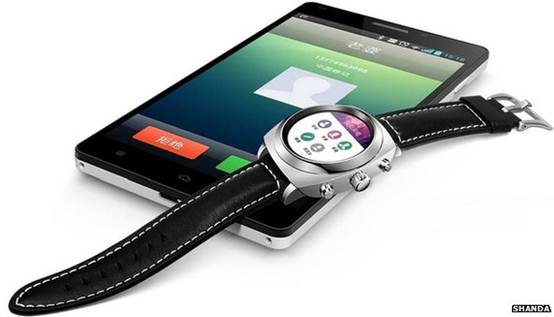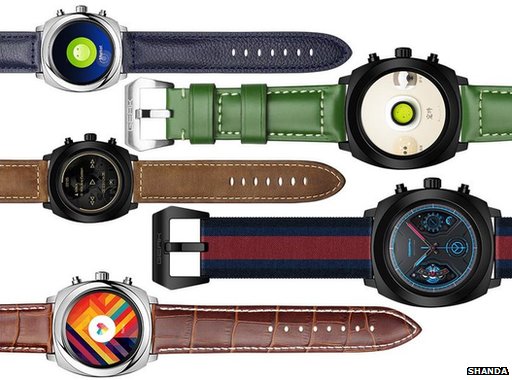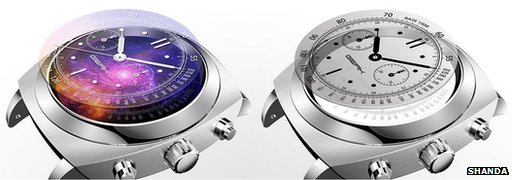
Geak Android
smartwatches 'last a week or more' between charges
By Leo KelionTechnology desk editor Form BBC

Shanda says its watches last six to 18 days
depending on the model and use of standby mode
One of China's leading tech firms has
unveiled two Android-powered smartwatches that it says can last about a week
between charges.
That represents a substantial gain on
alternatives that can struggle to run longer than a day.
The Geak Watch 2 models achieve the feat
by using a hybrid screen that switches between a "high definition"
LCD colour display and a "standby mode" battery-saving e-ink one.
One expert said this was "very
clever".
"One of the big challenges that
smartwatch manufacturers have had is that people stop using the devices, and
one of the reasons they do so is that they have to be charged on a regular
basis, whereby they are being taken off constantly," said Ben Wood from
the tech consultancy CCS Insight.

The basic version features a plastic
bezel, while the Pro model has a metal one
"Anything that enhances the battery
life is a big win.
"That's why we've seen people who
have Pebble devices typically using them longer than some of the rivals with
daily charging requirements."
Pebble smartwatches also promise
"up to seven days" between charges thanks to the use of a
black-and-white e-paper display, but lack the ability to switch to a colour LCD
screen or run Android, restricting the amount of apps they offer.
Two models
The new smartwatches are made by Shanda,
a Shanghai-based company that helped pioneer the sector with its first Geak
Watch in 2013.

The Geak Watch 2 models feature both an
LCD display and an e-ink one
Reviews at the time indicated that the
first-generation device lasted between
10 and 15 hours.
Early adopters are being rewarded with
an offer to trade in the old watch for a free new one.
Shanda says:
· the basic Geak Watch 2 lasts six days on a single charge
with normal use or 15 days if restricted to standby mode. It costs 1,999 yuan
($327, £203)
· the Geak Watch 2 Pro lasts seven days with normal use or
18 days if kept in standby mode. It costs 2,499 yuan ($409, £254).
Owners can alternate between the two display
modes by pressing a power button.
Both watches feature a circular 1.3in
(3.2cm) display offering a resolution of 254 pixels per inch when the LCD is in
use - roughly the same specifications as LG's G Watch R, which does not include
the e-ink component.
Shanda's Pro model features a metal,
rather than plastic, bezel and also includes a built-in heart rate monitor.
The models are powered by Geak Watch OS,
a proprietary "skinned" version of Android 4.3 that has its own app
store and user interface, rather than Google's Android Wear software.
This helps it overcome the fact that
Google Now - the anticipatory search service that provides much of Android
Wear's functionality - is blocked in China, where the Geak devices are sold.
Price erosion
Mr Wood said it was not yet clear
whether the hybrid screens matched existing watches in terms of display
quality, but said that if they did other companies might follow with similar
products made available worldwide.
"We're seeing a tremendous amount
of innovation in wearables coming out of China," he said.
"It's amazing how all of the
different manufacturers quickly follow successful ideas.
"But China is not only the
epicentre for innovation, it's also the source of extreme price erosion, which
is making things challenging for the established players."
Samsung, LG, Motorola, Sony and Asus are
among other companies to offer smartwatches that typically last about a day per
charge.
Many analysts have speculated that
Apple's Watch - a smartwatch to be released in 2015 - would boost sales across
the sector.
But there has been concern about Apple's
admission that battery life will be constrained.
"I think given my own experience,
and others around it, that you're going to wind up charging it every day
because you're going to use it so much," Apple's chief executive Tim Cook
said at the WSJD Live conference, according to a
transcript by the Verge news site.
Long-life LCDs
While improvements in the efficiency of
computer processors are helping compensate for the relatively slow pace of
battery tech advances, they can go only so far.
But research elsewhere in China might
offer an alternative to falling back on e-ink.
Researchers at Hong Kong University of
Science and Technology have reported that
they have created a new type of LCD screen that can hold a
static image for years without requiring power.
This could be suited to smartwatches
that change only a single digit every minute to show the time when not running
more complex apps.


